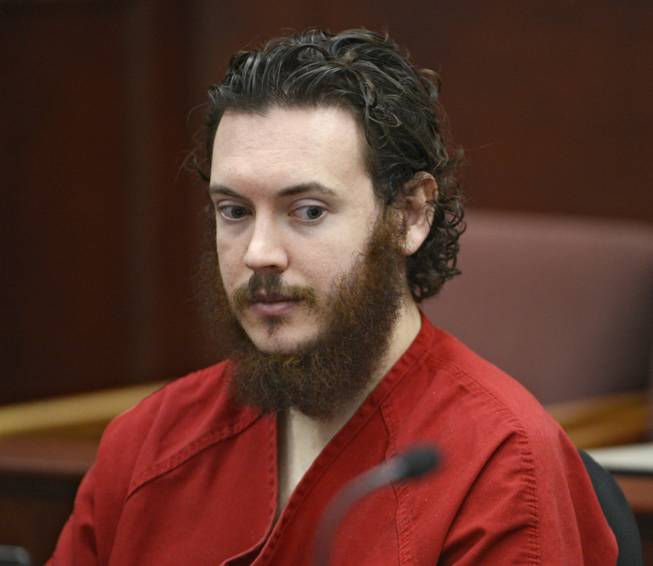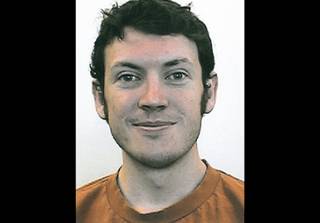
The Denver Post, Andy Cross / AP
Aurora theater shooting suspect James Holmes in court in Centennial, Colo., on Tuesday, June 4, 2013.
Published Monday, April 27, 2015 | 8:56 a.m.
Updated Monday, April 27, 2015 | 2:43 p.m.
CENTENNIAL, Colo. — A prosecutor declared Monday that two psychiatric exams found Colorado theater gunman James Holmes to be sane as he meticulously plotted a mass murder, considering a bomb or biological warfare before settling on a shooting so that he could inflict more "collateral damage."
"Meticulous" was how Holmes twice described his plans during the exams, District Attorney George Brauchler said at the start of a long-awaited trial to determine if he'll be executed, spend his life in prison, or be committed to an institution as criminally insane.
"Boom!" Brauchler said repeatedly as he showed pictures of the victims and the weapons that killed them on a screen, describing in detail how bullets pierced their organs and destroyed their limbs. "Boom!"
"I shot at people trying to get away. I shot at people trying to leave the theater ... to make sure others wouldn't follow," Holmes later told a psychiatrist, the prosecutor said.
The former neuroscience student has pleaded not guilty by reason of insanity to murdering 12 people and wounding 70 at a midnight "Batman" premiere nearly three years ago.
Many more people would have died, but a magazine on his AR-15 assault rifle jammed, leaving 218 bullets unfired, Brauchler said.
Jurors must eventually decide whether he was unable to know right from wrong because of a mental illness or defect when he slipped into the theater, unleashed tear gas and tried to empty his weapons on the crowd.
"Through this door is horror. Through this door are bullets, blood, brains and bodies. Through this door, one guy who thought as if he had lost his career, lost his love life, lost his purpose, came to execute a plan," said Brauchler, standing before a scale model of the theater.
"Four-hundred people came into a boxlike theater to be entertained, and one person came to slaughter them," the prosecutor said.
Holmes is accused of 166 counts of first-degree murder, attempted murder and an explosives offense for the mayhem he caused in suburban Denver on July 20, 2012.
It remains one of America's deadliest shootings, and that Holmes was the lone gunman has never been in doubt. He was arrested at the scene, along with an arsenal of weapons on his body and in his car.
Holmes sat quietly as Brauchler described his emotional rise and fall, interspersing facts about his life with poignant details about his victims.
The once-promising doctoral candidate told his ex-girlfriend that he had an "evil" plan "to kill people," but she dismissed his threat as "theoretical," the prosecutor said.
Turning away offers of help from his parents, friends and a therapist on campus, Holmes bought guns, protective gear, a detonation system and extremely flammable chemicals to blow up his apartment with. Holmes also got earphones to blast techno music to drown out his victims' screams, he said.
Dying his long hair a clown-like red had "nothing at all to do with the movie or being the joker," Brauchler said — Holmes did that to "be remembered."
"By the time he gets into that theater ... there is not a millimeter of flesh that is not covered by armor or some protective material," the prosecutor said. "He was wearing a kill suit."
Each side was allowed two hours for opening statements, with public defenders Daniel King and Katherine Spengler following his presentation.
Defense lawyers say Holmes was in the grips of a psychotic episode and could not tell right from wrong when he went on the rampage. His parents, Robert and Arlene Holmes, in pleading for his life, have called their son a "human being gripped by a severe mental illness."
Under Colorado law, the burden falls on the state to prove beyond a reasonable doubt that he was "NOT insane," Judge Carlos A. Samour Jr., told the jury. And that depends in part on "a culpable state of mind:" If Holmes acted with deliberation and intent — willfully taking actions that he knew would kill people -- then even if he had mental problems, he should be found guilty of murder, the judge said.
Prosecutors allege that Holmes planned the violence for months.
"He tried to murder a theater full of people to make himself feel better and because he thought it would increase his self-worth," Brauchler said. "I would like to focus on the victims," he said, but instead he must prove that Holmes was not insane.
The state has already spent millions seeking that verdict, managing an outsized number of victims, witnesses and more than 85,000 pages of evidence. Nearly three years passed hundreds of motions were filed in legal debates over capital punishment and insanity pleas.
Insanity defenses are successful in only 25 percent of felony trials nationally, even less so in homicides.
"Lay people tend to think of people with mental illness as extremely dangerous, and that also influences jurors, especially if someone has killed someone," said Christopher Slobogin, who teaches law and psychiatry at Vanderbilt Law School.
Most mass shooters are killed by police, kill themselves or plead guilty. A review of 160 mass shootings found killers went to trial 74 times, and just three were found insane, according to Grant Duwe, a Minnesota corrections official who wrote the book "Mass Murder in the United States: A History."
Just one has won a mental-health case in the last two decades: Michael Hayes, who shot nine people, killing four, in North Carolina in 1988. Based on that, Holmes "faces some pretty long odds," Duwe said.
Holmes was arrested almost immediately, while stripping off his body armor in the parking lot outside the Century 16 movie theater where he replaced Hollywood violence with real human carnage.
His victims included two active-duty servicemen, a single mom, a man celebrating his 27th birthday, and an aspiring broadcaster who had survived a mall shooting in Toronto. Several died shielding friends or loved ones.
At 6 years old, the youngest to die was Veronica Moser-Sullivan.
"That guy shot her four times. Four times! I'm not going to show you her picture now because you should only have to see it once," Brauchler said.
Veronica's mother, Ashley Moser, was left paralyzed and lost her unborn child, he added.
"When all is said and done," Brauchler said, "I am going to ask you to reject that man's claim that he didn't know right from wrong. I'm going to ask you to hold him accountable."


Join the Discussion:
Check this out for a full explanation of our conversion to the LiveFyre commenting system and instructions on how to sign up for an account.
Full comments policy